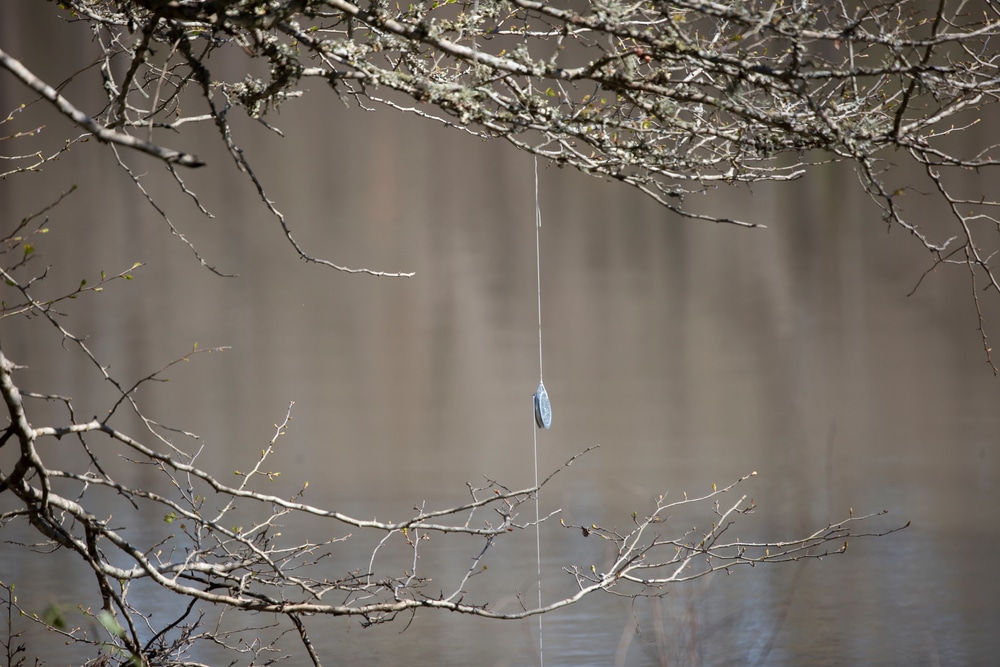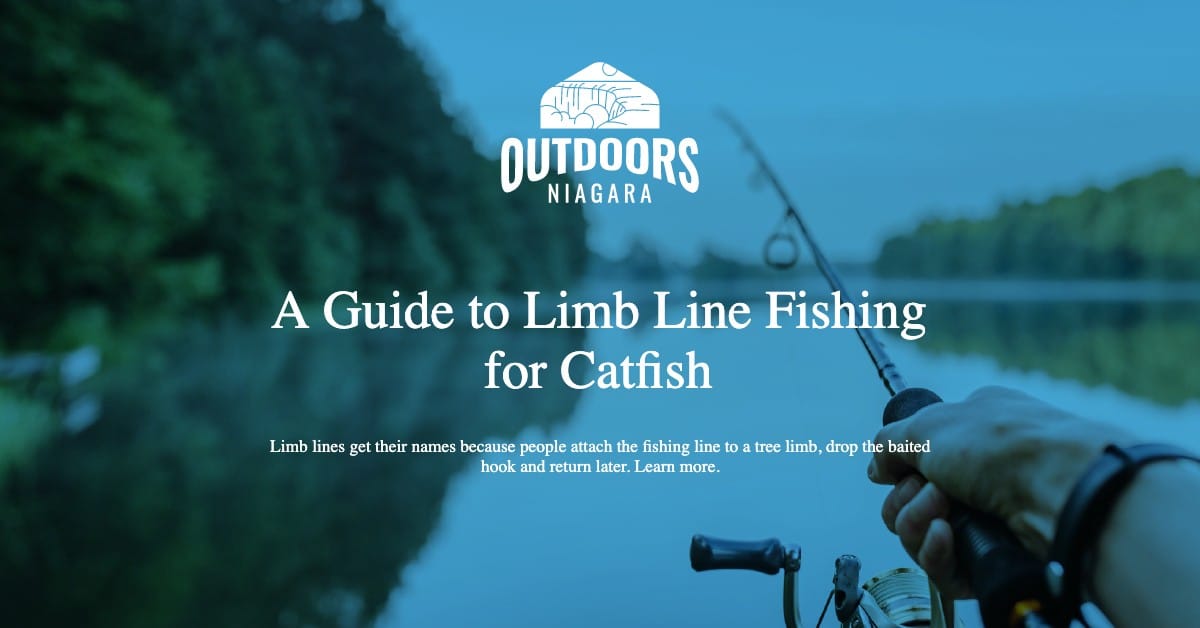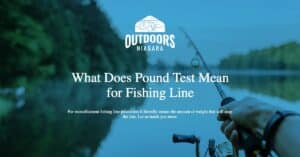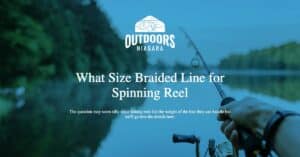Contents
What Is A Limb Line?
A limb line, which is also known legally as a Throwline or Set Line, is a fishing line that you deploy without a rod; instead, the line is attached to a fixed structure; in this case the live limb of a tree.
Limb lines get their names because people attach the fishing line to a tree limb, drop the baited hook into the water, leave, and return later to see if there is a fish on the line.
Tree limbs work well as a fixed anchor for the line, but you can use other flexible objects too.
If you choose a good limb, it will flex with the fish, and when it straightens it will set the hook for you. When you return, you wind in the line and net your catfish.
Limb lines are set and forget their lines, but you should check your limb line every two-three hours.
Note: Smart anglers set out multiple limb lines and make the round checking them.
How many limb lines you can legally set out differs from one state to the next.
Some states allow you to use limb lines in freshwater but not in salt water.
Some states do not allow you to use limb lines at all.

Can you use Limb Lines for Catfish?
In most states limb lines are legal, but you must check the regulations for where you want to fish to find out about which type of fish you can target and whether you can legally set Throwlines or set lines where you fish.
Limb lines are suitable for targeting catfish and so long as they are legal to use where you want to fish, then you can use limb lines for catfish fishing.
In fact, limb line fishing for catfish is a great way to get into catfish fishing.
The process is easy, affordable, and fun.
Because you do not need a rod or reel-to-limb line, the cost barrier to getting started is quite low.
Also, fishing for catfish usually occurs at night unless you are going to fish in deep water.
The catfish (most species) are far more active at night than they are in the daytime.
Because you set the limb line and leave it you are able to target more fish in the shallow water.
Catfish hunt in the shallows at night.
That makes limb line fishing ideal for catching big catfish.

How Do You Run A Limb Line for Catfish?
A limb line is set up much differently from the way you would rig a line for a fishing rod.
You use Trotline in a #9-pound test or weight rating.
Green is a good option for color, though the trot line comes in a few colors.
Hook size ranges from 2/0 – 5/0, and generally, you would just use a “J” hook though you can experiment with other types of hooks such as whisker hooks which are designed for catfish fishing.
You form a loop which is what you will secure the line to the limb with.
The loop is tied on one end of the line, and then you slip the rigging through the loop and snug it down on the limb.
Setting up the Limb Line
Tie a loop on the end of the line that is about two inches in diameter.
You will thread the rest of the rigging through this loop when you attach the limb line to the limb.
Spool off as much line as you need for your rig to rest along the bottom and your bait to remain about a foot off the bottom.
Catfish are bottom feeders so that is where you want your bait to sit, but not so close to the bottom that it becomes lost in whatever is on the bottom.
On the cut end of the line – that end that does not have the 2-inch loop – you will tie on your rigging.
With limb line fishing you do not need a leader, which is why many anglers prefer to use green #9 trotline.
The rigging is generally a sinker of 4-8 ounces that you tie about 12-15 inches from the end of the cut line.
Choosing the Right limb for Limb Line Fishing
Choose the right limb to support your line and then loop the rigging through the loop on the line and allow it to snug up on the tree limb.
A good limp is alive and flexible.
It should be at least an inch in diameter and able to support the tugging from a big catfish.
Do not use dead limbs as limb lines as the catfish will break them off, and you will lose your limb line.
More importantly is the fact that when the branch breaks, the catfish will be swimming around with a long limb line dangling from its mouth.
Fish responsibly and choose your limb carefully.
Be sure to check the limb line every two-three hours.
Catfish stuff you should know about…
What Kind of Fishing Line Should I Use for Catfish?
For limb line fishing for catfish, you want a #9 trotline preferably in green although some anglers who use limb lines choose brighter colors so that they can see the line in the water.
Catfish have poor eyesight and are generally not line-shy.
The limb line color is 100 percent up to you.
What Size Leader Line Should I Use for Catfish?
For catfish fishing with a rod and reel, you would use a 30-pound test mono or fluorocarbon leader line.
For limb line fishing you do not need a leader line, but you can use one if you want.
If you opt to use a leader line with your trotline, then go for the 30-pound test mono or fluorocarbon as a leader.
Do you Need a Leader Line for Catfish?
You generally use a leader line when fishing for catfish when you use a rod and reel.
For limb line fishing you do not need a leader.
You also do not need a leader, specifically when you fish with a rod and reel.
The benefit of using a leader with a rod and reel setup is that you can change rigging without cutting the length of the main line off of the spooled line.
If your main line is a braided line, then you would want to use a leader since a braided line is much harder to snap if your line becomes snagged.
What Kind of Bait for Limb Line Fishing for Big Catfish?
You can choose between live or dead bait. If you are targeting big Flathead Catfish, you would use live bait.
For most other types of catfish, dead shad are a good choice.
Keep in mind that catfish have big mouths so if you want the biggest catfish, use bigger bait.
For cut bait, a larger bream cut in half can be perfect.
You can also use bluegill, panfish, perch, or other fish for cut bait.
How Many Limb Lines Can You Employ?
The exact number of limb lines you can set out depends on the state in which you fish.
For example, in Kansas, you can set out no more than eight limb lines, or you can set out only one trotline with 25 or fewer hooks.
In Texas, a limb line cannot have more than 50 hooks.
As a comparison between just two states that’s a big variation.
To find out what is legal where you fish, check with your state’s fish and game department.
Is it better to set out one line with many hooks or many lines with one hook? If you are fishing for big catfish, it is better to set out a few lines with a single hook.
It will give you more options to target bigger fish.
When you choose to rig your trotline with many hooks, you are fishing by volume.
Those setups can be good for catching a lot of live baitfish.
For big catfish, one hook is good enough since the branch you tie the trotline to may not support two or more big fish.







